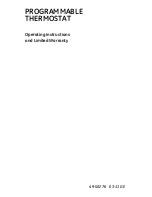
Model 42525A Version 4.0 5/05
5
Operating Instructions
Infrared Measurement Procedure
1. Turn the meter ON by pressing the POWER button. The meter display will countdown
(99999, 88888, 77777…00000) during the self-test procedure. When the self-test is
complete, the display will indicate a temperature reading, the unit of measure, the
emissivity setting, and the measurement type (IR for non-contact or Type K for contact
measurements).
2. Use the IR / TYPE K button to set the display to the IR mode (IR will appear in the
lower left-hand side of the LCD).
3. Set the temperature units (
o
C or
o
F) using the C/F button.
4. Point the IR sensor toward the object under test (to assist with targeting, press the
meter trigger to activate the laser pointer).
5. This meter has a “distance to spot ratio” of 6:1. Use the diagram below to determine
the proper distance to hold the meter from an object. For example, if the object under
test has a diameter of 4”, hold the meter at a distance of approximately 26”.
6. Read the LCD display for the temperature measurement. Note that the current
emissivity setting is shown on the lower right-hand corner of the LCD.
Infrared Measurement Considerations
1. The 42525A automatically compensates for ambient temperature deviations; however
it may take up to 30 minutes to adjust to extremely wide ambient temperature changes.
2. When low temperature measurements are taken followed by high temperature
measurements, several minutes are required for stabilization before the high
temperature measurements can be made accurately.
3. Measurement Field / Distance: For optimum accuracy, the object should be 1.5 to 2
times larger than the spot size shown in the diagram above and on the meter side.
4. Measurement Interference: Objects having low emissivity or objects with low
temperature yet high emissivity emit little IR energy. Such objects are adversely
affected by IR energy radiated from nearby objects having high emissivity and
temperature. For example, when such objects are measured in sunlight, erratic
readings occur because of the powerful radiation (sunlight) reflected off of the object's
surface into the 42525A sensor.
5. If the surface of the object under test is covered with frost, oil, grime, etc. clean before
taking measurements.
6. If an object's surface is highly reflective, apply masking tape or flat black paint
(emissivity 0.95) before measuring.
150
125
100
75
50
mm
6
5
4
3
2
inch
1000
840
670
500
330
mm
40
33
26.4
20
13
inch
Diameter of Spot
Distance to Object


























